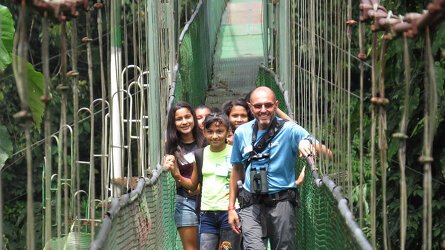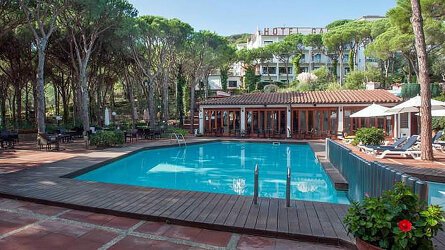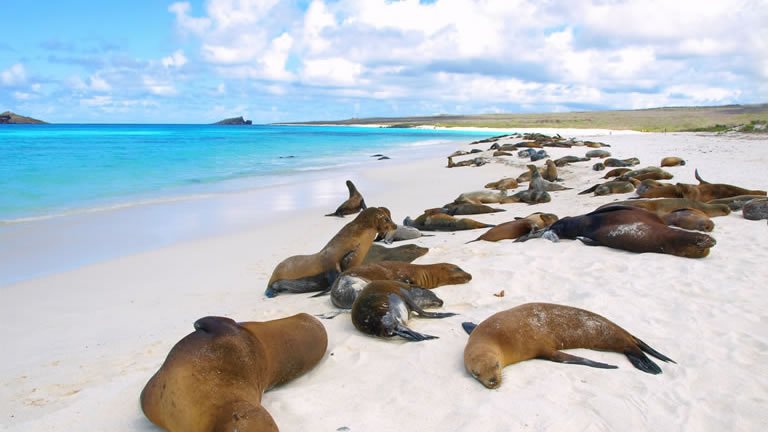Overview
This eight-day itinerary aboard the Archipel I catamaran combines the seabird colonies of North Seymour and the exclusive Genovesa Island with the spectacular volcanic island Bartolomé and the Charles Darwin Research Station. Also explore Española, the southernmost point of the archipelago, and swim with sea lions in the Loberia of Isla Floreana.
Itinerary
The adventure starts in Quito, aim to arrive at the hotel this afternoon/evening. Free transfers are available for all clients – check the Joining Instructions for more information. A local guide will welcome you to Quito and explain the schedule for the next few days. Stay: Hotel Casona de la Ronda (or similar).
Today is free to relax, recover from the flight and explore the fascinating city of Quito, the second-highest capital in the world, standing at 9,350ft (2,850m) on the western cordillera of the Andes. It is one of the smaller and more attractive of the colonial capitals in South America. Visitors to Quito are advised to take it easy at first because of the altitude. Stay: Hotel Casona de la Ronda (or similar) (B).
Morning: Fly to Galapagos Transfer to Quito Airport and fly to Baltra Airport in the Galapagos Islands.
Upon arrival, you pass through the airport inspection point to make sure no foreign plants or animals are introduced to the island, and to pay the national park entrance fee. Your guide will meet you, help you collect your luggage and escort you on a short bus ride to the harbour where a dinghy will take you to the yacht. Afternoon: Bachas Beach (Santa Cruz) This is a lovely bay with soft, white coral sand frequently visited by egg-laying sea turtles – watch your step!
After enjoying leisure time at the beach, you could explore a small lagoon hidden behind bushes, where occasionally it is possible to observe flamingos, black-necked stilts and whimbrels. You might also see rusty barges, which were abandoned here after the Second World War when the USA rented this island as a strategic point to protect the Panama Channel from Japan. Stay: Archipel I (B/L/D).
Morning: Prince Philip's Steps Genovesa has a royal touch. Follow in the footsteps of Prince Philip – who admired the Galapagos for many years – and visit this favourite birding spot, home to the largest breeding colonies of red-footed and nazca boobies and short-eared owls, which hunt on foot. Afternoon: Darwin Bay One of the outer islands and among the most exclusive spots on the Galapagos, Genovesa is well worth last night's longer navigation. This compact site displays the varied coastal ecosystems of the Galapagos in miniature – nearly too much for a single day. Stay: Archipel I (B/L/D).
Morning: Bartolomé This tiny volcano islet is just recently born out of fire. Enter its wild setting of spatter cones and craters and admire beautiful panoramas of the Galapagos. Afternoon: Sullivan Bay (Santiago) Sullivan Bay is incomparable to any other site; setting foot on the recently solidified lava flow is like walking on the moon. Stay: Archipel I (B/L/D).
Morning: El Chato Reserve – Twin Craters El Chato Reserve is a protected area and part of the Galapagos National Park, extending from Cerro El Chato as far down as the southwestern coast of Santa Cruz Island. Afternoon: Fausto Llerena Breeding Center On a tour of the Fausto Llerena Breeding Center, you can see the tortoises of Española Island, ending in the tortoise exhibit corral. Tortoises of this corral are accustomed to humans – an excellent chance to capture a photo for your wall back home. Stay: Archipel I (B/L/D).
Morning: Cormorant Point and Devil's Crown The peninsula of Cormorant Point forms the extreme north cape of Floreana, which exists out of smaller volcanic cones, covered by a tropical dry forest of palo santo. At the landing beach, you will be welcomed by a small Galapagos sea lion colony. The green sand on this beach contains a high percentage of glassy olivine crystals, which have been blown out by the surrounding tuff cones. The flour-sand beach on the southern side of the peninsula is made of even finer white-coral sand, which feels very smooth on the feet.
Parrotfish have pulverised it, grinding the calcareous skeletons of living coral. You can spot schools of stingrays who love the sandy bottom to hide. During the first months of the year, Pacific green turtles come ashore to bury their eggs. Devil's Crown is one of the best snorkelling spots in the Galapagos due to the coral reef in its centre, which attracts a lot of marine life. Here you can spot Galapagos penguins, sea lions, sea turtles, many different colourful fish and even dolphins.
The current can be a bit strong sometimes, so it should not be attempted by novice swimmers. Afternoon: Post Office Bay and Baroness Lookout Historically, this site was the location of a wooden barrel placed by an 18th-century whaling ship crew; letters placed inside were collected and delivered by sailors returning home. Tourists still leave thousands of letters here today and many still reach their destination. You can also relax on the beach at Post Office Bay, where you may see Galapagos sea lions, Pacific green turtles, golden rays and Galapagos penguins (this is the only place in the southeastern archipelago where penguins reside).
You can also climb Baroness Lookout, a small basaltic cone, and enjoy paradisiacal views of the coastline. This viewpoint was the favourite spot the eccentric baroness and self-proclaimed Empress of Galapagos, Eloisa von Wagner, who was one of the first settlers on Floreana. Stay: Archipel I (B/L/D).
Morning: Osborn Islet and Gardner Bay The striking white beach at Gardner Bay is an important breeding site for Pacific green turtles. However, without a doubt, its main attraction is the Galapagos sea lion colony. Females stay year-round in this nursery, suckling their pups until they are three years' old, although they start to fish at five months. During the breeding and mating season, the colony becomes even bigger. Afternoon: Suarez Point The west tip of Española is a dream for birdwatchers and photographers. Feel as though you're within an exciting nature documentary and hike a short distance from colourful marine iguanas. Stay: Archipel I (B/L/D).
Morning: Pitt Point Two wind-sculpted tuff cones at Pitt Point constitute the easternmost end of the Galapagos and were the first sight of land for the crew of Darwin's HMS Beagle. Afternoon: Witch Hill Enjoy a leisurely afternoon in Witch Hill's crescent-shaped beach of soft powdery sand. Stay: Archipel I (B/L/D).
Morning: Lobos Islet (San Cristobal) and Transfer to San Cristobal Airport The Lobos Islet's beach harbours a colony of Galapagos sea lions. As in other colonies in the archipelago, you can approach nurturing females within a few metres. In the breeding season, this colony is also visited by territorial males, defending and mating the harem on their part of the beach.
This low islet is home to more than just Galapagos sea lions, two other emblematic species breed here: male blue-footed boobies and great frigate birds who try to impress the females (and tourists) with clumsy dances, heaving their striking blue feet or blowing up their balloon-sized scarlet pouches. Assisted by the naturalist guide and some crew members, the dinghy will bring you and your luggage to San Cristobal, where we take the airport shuttle. From here, we fly to Guayaquil where it's possible to connect with international flights from 6pm onwards (B).
Trip Inclusions
- Seven nights aboard Archipel I exploring the Galapagos Islands
- Experience incredible wildlife viewing and photographic opportunities with near-tame animals
- High chance of spotting waved albatrosses, blue- and red-footed boobies, Galapagos giant tortoises, Galapagos sea lions, Galapagos penguins, land and marine iguanas, American frigatebirds and short-eared owls
- Fantastic on-board service with experienced naturalist guide
- Travel by internal flight, motor yacht and minibus
- 9 Superior night (2 hotel, 7 catamaran)
- All breakfasts, seven lunches, seven dinners
- All transport and listed activities
- Tour leader throughout
- Snorkel equipment (mask, snorkel and fins) available free of charge on board
- Itinerary and inclusions are subject to change
- Price is for land, cruise and internal flights as specified. Flights not specified are not included

Enjoy thrilling animal encounters from the isles of the Galapagos to the plains of Africa. Read more

Exodus chooses their Leaders carefully. Professional, dedicated and are passionate about sharing their home countries. Read more

Wherever possible, Exodus chooses properties that are locally owned and that reflect the area you are visiting. Read more
Availability
A definite departure means minimum numbers have been reached for this departure to operate. Your Global Journeys Travel Advisor will check the availability of your departure date when you enquire. Additional savings may apply. We guarantee the lowest price in Australia. T&C’s apply.
Tour & cruises prices are per person. Prices shown have savings applied, are subject to availability and may be withdrawn at any time without notice. Pricing and trip details are correct at this point in time, however are subject to confirmation at the time of booking and are subject to change by Exodus. For cruise itineraries, cabin images are sourced from Exodus. These should be treated as indicative only. Cabin inclusions, upholsteries and room layout may differ to the image(s) shown depending on the ship selected and your sailing dates.









